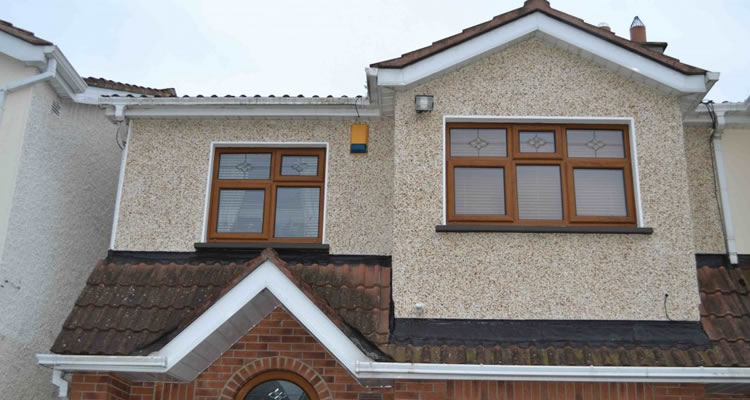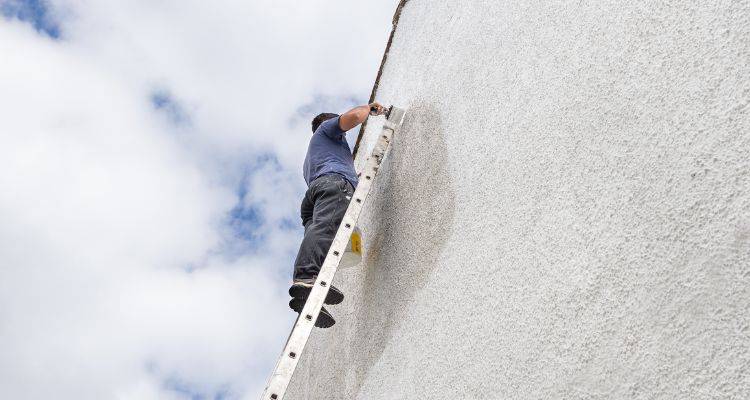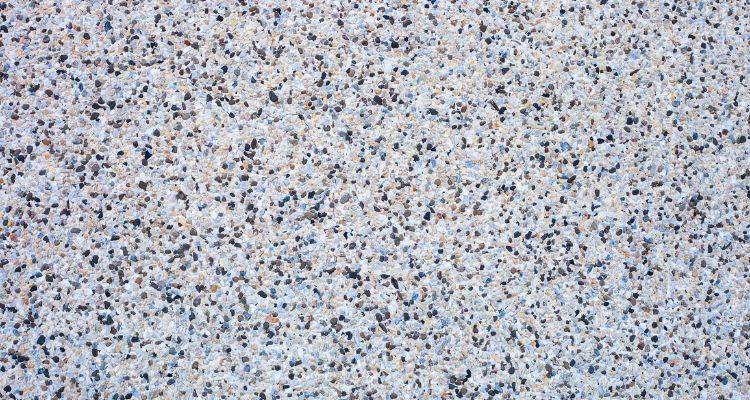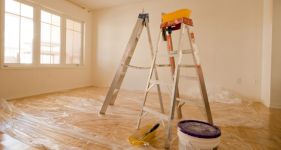Cost to Pebble Dash a House
- The average cost of pebble dashing a home is around £4,000.
- The job will usually take anywhere between 3 to 14 days.
- A breakdown of pricing information including types of pebble dash and what such a task typically involves.
- How long the job will typically take and a general overview of what types of jobs can be performed.
- How to find and hire a pebble dasher.
Want to know how much it costs to pebble dash a house?
In this guide, we look at pebbledash prices for different sized houses, pebble dasher fees, pebble dash render and how much removing pebble dash costs (which on average, is around £4,000).
Ready for a quote?
We have a range of pebble dashers near you who are ready to give you free, no-obligation quotes!
So, for all the information check out the article below!

£4,000
Table of Contents
- How Much to Pebble Dash a House?
- Labour Costs and Timescales
- Supply Costs
- Additional Costs
- What Impacts Pebble Dashing Costs?
- What Is Pebble Dash?
- How to Pebble Dash a House
- Can I Pebble Dash a House Myself?
- What Type of Pebble Dash Should I Use?
- Pebble Dash Finishing Options
- Pebble Dash Alternatives
- Pebble Dash Vs Render
- Cost of Painting Pebble Dash
- Modern Pebble Dash Colours
- Cost of Pebble Dash Maintenance and Repairs
- How Much to Remove Pebble Dash?
- Checklist: Hiring a Pebble Dash Specialist
- FAQs
How Much to Pebble Dash a House?
Pebble dashing your home will give it a whole new look. It’s a great way to improve the aesthetics of the outside of your home and is also an effective way to increase the resale value of your property if you decide you want to sell your home.
Pebble dashing will cost roughly between £2,000 and £3,000 depending on the size of your home. For example, the pebble dash price for a 2-bedroom terraced house will cost around £2,100 to £4,800 whereas the cost to pebble dash a 4-bedroom detached house will cost around £2,700 and £9,200.
It’s important to hire the right specialists for a pebble dashing job. You want to ensure that the right equipment is being used and that the right materials are being used. This is not the kind of project that can be done as a DIY job over a weekend.
Removing all rubble, rendering the siding, improving the roof, and improving the side appearance are all parts of the job that should be included in the price. Take the time to choose the best contractor for the job so that you can ensure that you get the most affordable pricing and the most qualified professionals for the job.
No matter the reason for you choosing a pebble dash, it is the perfect way to improve the appearance of your home.
My house has patches of broken pebbledash and various cracks that need repairing before it can be repainted. I'm not sure what kind of tradesperson I need?
Pebble Dash Prices
The following table indicates the prices involved with pebble dashing houses based on their size.
| Job Description | Duration | Material Cost | Labour Cost | Total Average Cost |
|---|---|---|---|---|
| 2-bed terraced house | 3 - 7 days | £400 – £600 | £300 – £600 per day | £2100 – £4,800 |
| 3-bed semi-detached house | 6 - 8 days | £500 – £700 | £300 – £600 per day | £2,300 – £5,500 |
| 4 bedroom detached house | 1 - 2 weeks | £600 – £800 | £300 – £600 per day | £2,700 – £9,200 |
| Typical medium-sized bungalow | 6 - 8 days | £500 – £700 | £300 – £600 per day | £2,300 – £5,500 |
Labour Costs and Timescales
Depending on the size of your property, it should take between 3 and 14 days to pebble dash your home. You will have to pay labourers on a daily basis. It will typically cost around £140 to £160 per labourer, per day. You should expect at least two labourers to be working on pebble dashing your home each day.
The more labourers you have working on the project, the more it will cost per day. However, in turn, this will reduce the time-frame that it will take to get the job completed.
Supply Costs
Depending on the type of pebble that you are looking for, you should expect to pay anywhere between £8 and £20 per 25kg for the pebbles. A plain Limestone pebble dash is priced at around £8 to £10 per 25kg and a mixed-coloured Flint pebble dash works out more expensive at around £18 to £20 per 25kg.
The cost for supply only of cement for the job works out at around £40 to £60 per metre squared and the average cost for the supply of lime only should set you back around £90 to £110 per metre squared.
Additional Costs
There are some additional costs that may occur for a pebble dash. These additional costs may include:
- External painting costs – If you would like to have your pebble dash coated in paint as a finishing touch, you will be looking to pay around £10 to £25 per metre squared.
- Trowel – A trowel for the pebble dash will cost between £15 and £25.
- Scaffolding costs – If your job requires scaffolding, this could add on an extra £750 to £1,000 to the job.
What Impacts Pebble Dashing Costs?
There are a number of factors that may increase or decrease the cost of your pebble dashing project. The following list indicates some factors that may affect the cost:
- Where you live can affect the cost. London is the most expensive area and could cost you up to £30 to £100 more per metre squared when compared to getting your home pebble dashed in the north of the UK.
- If you live in a bungalow, the labourers won’t need to use scaffolding. This could save you around £750 to £1,000.
- Whether or not you choose to have your pebble dash painted after the job is complete can affect the price of the entire job. You could save a considerable amount of money by leaving your pebble dash as it is. The best option may be to choose a pebble dash that has a beautiful appearance without paint.
- If you have a chimney on your property, or if you have extra storeys on your home then extra scaffolding will be required and this could bump the price up by a further £500 to £1,000.
- If you have a lot of windows on your home, this can make the job more difficult and will, therefore, push up the cost of the project.
- The size of your home is also a major factor in the cost of your pebble dashing project. The price of pebble dashing a 2-bedroom terraced house is around £2,100 to £4,800 whereas the cost to pebble dash a 4-bedroom detached house is around £2,700 to £9,200.
What Is Pebble Dash?
Pebble dash is a type of rendering that is used for the external walls of a building. It features a top layer that is textured by stone and decorative aggregates to create a rough finish. The surface of the wall is rendered with lime and cement and then the pebbles are thrown onto it and pressed in while it is still wet.

Pebble dashing became a popular form of rendering between the 1890s and the 1930s. It was brought in as part of an arts and crafts movement which was developed to revive traditional building structures and create a new form of architecture.
Pebble dashing became widely used in the post-war years of housing development. Often pebble dashing was a way of covering up poor workmanship on early buildings.
Pebble dashing is used as a way of adding a new aesthetic to an existing home. It completely changes the look of a building and adds a completely different vibe to the outside look of your home.
How to Pebble Dash a House
Pebble dashing is quite a difficult job, particularly if you have never done it before. The following list explains the steps that it takes to pebble dash an exterior wall.
Step One
Mix up the lime with water according to the manufacturer’s instructions and then leave it covered up to hydrate for a minimum of 24 hours.
Step Two
Mix up one-part of the slaked lime with one-part cement and six-parts sand. This will provide the base mixture needed to spread onto the wall.
Step Three
Trowel this mixture onto the wall in which you are pebble dashing. Keep the trowel level and use the edges of the trowel to create a flat, smooth layer of the mixture on the wall. This will act as the base layer.
Allow this base layer to dry for around an hour. Then, rake the surface with a notched trowel. This will create a grooved surface that makes it easier for the second coat to stick. Allow this layer to dry for at least 24 hours.
Step Four
Rinse all of your pebbles and completely drain them. Lay them in a large bucket or a large flat bin and then set them beneath the wall in which you are pebble dashing.

Step Five
Mix up your top coat of five-parts sand to one-part cement and one-part slaked lime. Trowel this mixture over the base layer and use the trowel to smooth it out to create a flat, even top layer.
Step Six
Spread a plastic sheet out below the wall you are pebble dashing to help capture any loose pebbles as they fall. This allows you to easily collect them up again for re-using until the wall is completely covered in pebbles.
Step Seven
Hold the bucket of pebbles below the wall that you are pebble dashing and then scoop some of the pebbles up with a trowel or scoop. Throw these pebbles at the wall. Some of the pebbles will stick to the cement while others will fall to the floor onto your plastic sheet. Continue throwing the pebble dash at the wall until your wall is completely and evenly covered in pebbles.
Step Eight
Once your wall is completely covered, go over each section of the wall and lightly press and fit the pebbles into the wall with the flat back of your trowel and leave the wall to dry for at least 24 hours.
Complete the above steps on all of the walls on your house that you would like pebble dashed.
Can I Pebble Dash a House Myself?
Pebble dashing a house is not at all a simple project and so it is not recommended that you try to install it yourself. Although you could save yourself £900 to £8,400 in labour costs by completing the job yourself, it is an extensive job that takes a lot of work and a lot of time. It can also be a very dangerous job, particularly if you are working at heights.

Pebble dashing often also requires the use of commercial-grade equipment and supplies, so a contractor that has access to these pieces of equipment will be required. Most homeowners simply do not have the knowledge, skills, and time needed to complete this kind of job on their own.
It is important to hire a contractor that is qualified and capable of carrying out a high-quality pebble dash. Ensure that you hire a team that uses high-quality materials and guarantees the work that they perform.
Is it easy and safe to make pebble dash plaster DIY? Or should it really always be left to a professional?
What Type of Pebble Dash Should I Use?
Pebble dash can come in a number of finishes including marble, flint, and limestone. Each of these options results in a beautiful pebble dash finish. However, the cheaper options of pebble type such as limestone can be prone to staining over time.
A plain limestone pebble dash is priced at around £8 to £10 per 25kg and a mixed-coloured flint or marble pebble dash works out more expensive at around £18 to £20 per 25kg.
There are a number of advantages and disadvantages of using different types of stone. Below is a list of the pros and cons of each type.
Marble Pebble Dash Cost
Marble is a beautiful, natural stone that offers a variety of colours and has a great finish. The average cost of marble pebble dash is £18 to £20 per kg.
Pros
- ✔ Upscale, elegant appearance
- ✔ Wide variety of colour options available
- ✔ Offers a glistening effect
Cons
- ✖ Can be quite expensive in comparison to other options
- ✖ Can develop some staining over time
Flint Pebble Dash Cost

Flint is a beautiful finish of stone that has the benefit of coming in a variety of colours. The average cost of flint pebble dash is £18 to £20 per kg.
Pros
- ✔ Wide variety of colour options available
- ✔ Stain and corrosion resistant
- ✔ Scratch-resistant
- ✔ Beautiful appearance
Cons
- ✖ Can be quite expensive in comparison to other options
- ✖ Colour may fade over time in the sunlight
Limestone Pebble Dash Cost
Limestone is a great option for pebble dashing your property if you are on a fixed budget. The average cost of limestone pebble dash is £8 to £10 per kg.
Pros
- ✔ Budget-friendly option
- ✔ Beautiful natural look
Cons
- ✖ Can be prone to damage
- ✖ Can be prone to staining over time
There are a number of different types of pebbles dash. The most popular option is a dry pebble dash, which involves throwing the pebbles at a cement mixture covered wall and pressing the stones into the wall and allowing them to dry onto the surface.
Pebble Dash Finishing Options
There are some other options available if you are interested in a more unique style of pebble dash. Below are some other options of pebble dash available and the process behind each one.
Wet Dash (or Roughcast)

A wet dash is when pebble and stone chippings or Spar are mixed into the final coating of mortar. This mixture is then sprayed or cast onto the wall. This is a traditional finish of pebble dash on homes all around the UK, however, it has generally become a much less popular option in recent years.
Harling
Harling is also considered to be a traditional pebble dash finish. It is seen mostly on houses in Scotland and Ireland. Traditionally, Harling was a lime-based product that was cast onto exterior walls using a flicking method.
The process involves layering lime until it reaches the desired effect. This is also a useful type of covering for walls that have been poorly maintained or for covering up old brickwork.
Tyrolean or Stucco
Tyrolean or stucco is another traditional type of finish that is mostly seen on properties in England and Wales. It involves using a tyrolean gun to build up layers until the desired finish is achieved. This method is great for covering up walls that have old or poorly conditioned brickwork.
Pebble Dash Alternatives
There are a number of alternative render options available as an alternative to a pebble dash. The list below highlights some alternatives to a pebble dash along with some information on each of these alternatives.
Acrylic Render Cost
With an acrylic render, acrylic or polymer ingredients are used to bind this type of render. It is usually pre-made and will arrive at your home in tubs. It can even be pre-coloured if you wish so your home can have a lovely vibrant and unique finish to it. Acrylic render costs around £40 to £60 per metre squared.
Pros
- ✔ Durable
- ✔ Can be pre-coloured
- ✔ Arrives ready-made
Cons
- ✖ Waterproofing qualities aren’t great
- ✖ Can attract algae
Silicone Render Cost
A silicone render also has the benefit of having a huge choice of colours, but has an added level of waterproofing. It self-cleans by staying dry and even sometimes features alkaline content that discourages algae.
Silicone render is seen as more of a premium type of render and therefore comes with a high price. Silicone render costs usually fall somewhere between £50 and £70 per metre squared.
Pros
- ✔ Waterproof
- ✔ Self-cleaning
- ✔ Comes in a number of colours
Cons
- ✖ Expensive
Monocouche Render Cost
This method uses cement as a hardening agent and the overall thickness of the render is designed to be 15mm. The material will arrive at your property s a dry mixture that is ready to be blended with water. The first 4mm is a bottom base which is a polymer enriched render and includes a mesh. The remaining 11mm of monocouche mixture is then applied over the top.
It can be provided in a number of colours and can be finished with a smooth look, a textured look, or a rusticated look to make it look like stone. It costs a similar amount to silicone at around £45 to £65 per metre squared.
Pros
- ✔ Available in a number of colours
- ✔ Can come in a number of finishes
- ✔ Durable
Cons
- ✖ Expensive
Lime Render Cost
Lime render is a traditional type of render that hasn’t been used much over the past half a century. It gives a wonderful characterful look to your home. It is a specialist product and can be difficult to apply.
It usually needs three coats between 8mm-10mm in thickness to create the desired look. The mixture will be calculated based on the specific property and can acceptably be cured within 28 days, however, it doesn’t usually completely set for up to a year. Lime render costs around £50 to £60 per metre squared.
Pros
- ✔ Characterful look
- ✔ Unique
Cons
- ✖ Expensive
- ✖ Has to be applied by a specialist
- ✖ Takes a long time to set
Pebble Dash Vs Render
A pebble dash involves throwing pebbles at a base render to create a unique textured look, whereas a simple render involves creating a smooth or textured appearance with layers of the mixture. Both pebble dash and render create a unique look for the home, and they are both great for covering up old or worn brickwork.

Both pebble dash and rendering can come in a huge range of colours. Pebble dash colours are based on the colours of the pebbles, whereas a render can usually be mixed to any colour that you would like.
Is mid-October too late to start pebble dashing a house?
Cost of Painting Pebble Dash
It is possible to paint a pebble dash, however, it is not the most straightforward of jobs. The rough and heavily textured nature of a pebble dash means that painting it with traditional methods such as a brush and roller just won’t suffice. It will take a lot more effort to paint a pebble dash than simply going over it with a brush or roller.
When using a brush to apply paint to a pebble dash, you will need to use a dabbing or stippling motion to ensure that every little visible area of the dash is covered with paint.
If you are using a roller, you will need a long pile roller to ensure the rough texture gets a good, even coating of paint. If the walls you are painting are high, scaffolding may be required to complete the job. This will set you back around £40 to £150 per day depending on the size and complexity of your property.

The prices for painting your external pebble dashed walls can vary depending on the size of your property. Below is a table explaining the prices and timeframes you should expect for a pebble dash painting job.
| House Type | Average Cost | Duration |
|---|---|---|
| 2-bedroom terraced house | £700 – £1,000 | 5 – 6 days |
| 3-bedroom semi-detached house | £900 – £1,200 | 7 – 8 days |
| 4-bedroom detached house | £1,000 – £1,300 | 8 – 9 days |
Below is a list of the costs that may be involved with painting the exterior walls of your home.
- High-quality masonry paint - £3 to £5 per litre
- Stabiliser - £2.50 to £3.50 per litre
- Tubs, brushes, and rollers - £25 to £35
Modern Pebble Dash Colours
Pebble dash is often associated with traditional grey and beige tones, but modern pebble dash colours and finishes are available to suit a range of styles and aesthetic preferences.

Depending on the stone mix, you can achieve the following pebble dash house colours:
- White and light grey - typically made by mixing white spar chippings or quartz, giving a bright finish.
- Earthy yellow tones - found in most spar dash mixes, with a warming tone.
- Dark grey and black - made with black or charcoal basalt for a high-contrast, contemporary finish.

It's important to consider your home's surroundings when choosing pebble dash colours to make sure you don't stand out for the wrong reasons:
- City-centre houses - Darker dash mixes, such as greys and charcoals, will be in keeping with other city structures like skyscrapers and office blocks. Using a white pebble dash render can help brighten up typically dark areas for a fresh look.
- Countryside houses - Choosing a sympathetic pebble dash colour is important in rural settings. These properties lend themselves more to the earthy tones of yellow, tan, and light grey, in places where stark high-contrast colours might not work as harmoniously.
If you're looking for modern pebble dash colours, you can experiment with duo-toned pebble dash designs to create pastel hues.

It's important to remember your house's design when choosing your colours to ensure the pebbledash shade matches your roof's colourings and the overall building design.
For example, mixing bright white pebbledash stones with a slate roof might be too much of a contrast, but a mid-to-light-toned grey could be complementary.
Cost of Pebble Dash Maintenance and Repairs
Repairing a patch of pebble dash can be quite a simple job, however, it can be difficult to replicate the colour of the existing pebbles that are most likely weather-worn.
The old pebbles that have fallen loose may be collected up and mixed in with the new ones if possible, and this may help to offset the colour contrast. Despite this, the slightly different colour of pebbles looks much better than a bare patch of rendered wall.
Take the following steps to repair a patch of pebble dashed wall.
- Soak lime by adding water and mixing it until it is the consistency of thick cream. Cover this mixture up and leave it to soak for at least 24 hours.
- Place a plastic sheet underneath the area that you are repairing. Tap the damaged area with a hammer so that any loose pebbles come away from the wall. Brush out the remaining loose material.
- For the base coat, mix one-part cement with one-part of the lime mixture and add six-parts of sand. Wet the damaged area so that the render retains moisture and prevents crumbling. Apply the base coat to the damaged part of the wall using a trowel and make sure the entire area is filled and it is smooth. Fill it to around 13mm below the level of the existing render.
- Roughly an hour later, before the base coat has completely hardened, scratch it with a pointed tool to give it a key and then allow it to dry for at least 24 hours.
- So that the pebbles bond firmly, rinse the shingle and allow it to drain. The pebbles don’t need to be completely dry before using, as long as they have been well-drained.
- Mix the top coat of rendering mortar with one-part cement, one-part lime, and five-parts sand. The consistency of this mixture should be slightly softer than the base coat. Apply this top layer over the base layer on the wall. Using a shovel or trowel, throw the pebbles onto the wall and gently push them in place with the back side of the shovel or trowel. Ensure that the area is completely covered to the point that it matches up with the rest of the wall.

The price to patch pebble dash by a professional will depend on the size of the area that needs repairing, and whether scaffolding is needed to complete the job. You will be looking at a cost of around £100 to £200 for the labour costs, plus the cost of materials needed.
The cost of materials will depend on the size of the area that needs repairing. A tradesman may need to come out and asses the damage before they can provide you with a quote.
In order to maintain your pebble dashed wall, a simple hose spray will do the trick in keeping it nice and clean and free of debris or dirt.
How Much to Remove Pebble Dash?
Removing a pebble dash render is not a simple task and will require hiring a professional to carry out the job. There is some risk when removing pebble dash as the brickwork underneath can become damaged if it is not done carefully and correctly.
If you do decide that you want to have your pebble dash removed, you will need to carefully consider who you hire to carry out this job. You will need to choose a tradesperson or business who has experience in removing pebble dash.
If your pebble dash is removed with too much force, this can significantly damage the underlying substrate and can even invalidate your home insurance.
Below is a table indicating the costs of a pebble dash removal depending on the size of your property. The prices below include the cost of labour and materials as needed.
| House Size | Job | Average Cost | Duration |
|---|---|---|---|
| 2-bedroom terraced house | Removing pebbledash and replacing with flat render | £3,000 – £4,500 | 4 – 7 days |
| 3-bedroom semi-detached house | Removing pebbledash and replacing with flat render | £3,800 – £5,200 | 5 – 8 days |
| 4-bedroom detached house | Removing pebbledash and replacing with flat render | £6,300 – £7,800 | 1 – 2 weeks |
| Typical medium-sized bungalow | Removing pebbledash and replacing with flat render | £2,100 – £3,000 | 4 – 6 days |
Checklist: Hiring a Pebble Dash Specialist
There are some things you will need to consider when hiring a contractor to carry out your pebble dashing work. Below are the major points that you will need to consider when finding the right company for the job.
- Choose a company that specialises in pebble dashing homes.
- Find out what materials the company uses so you can be sure that you are getting high-quality materials.
- Ask about any guarantees and warranties that the company offer for their work.
- Get at least three quotes for the work so that you can be sure that you are getting a good price for the work needed.
- Find out how long the company will take to carry out the work
- Ask for a breakdown of the costs so that you can be sure that you’re paying an appropriate amount for each different element of the job.









